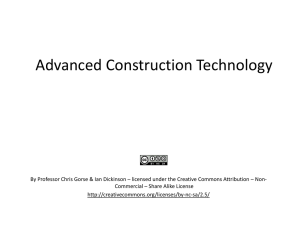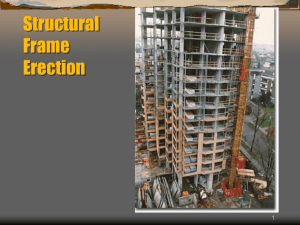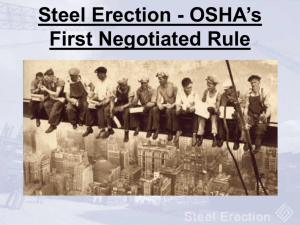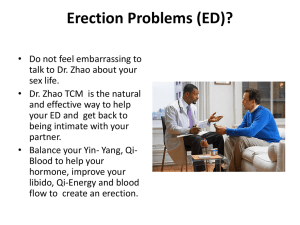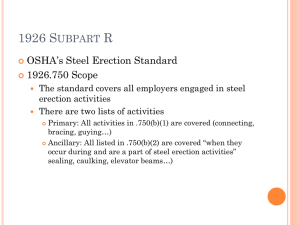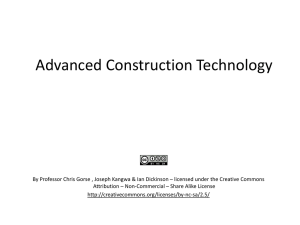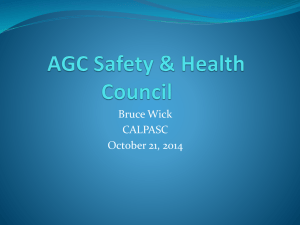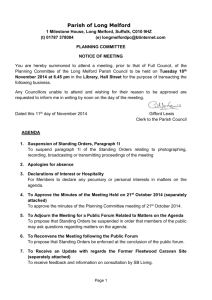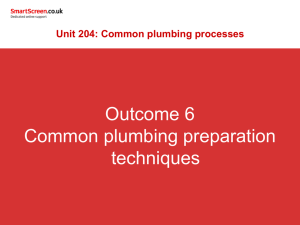Subpart R
advertisement
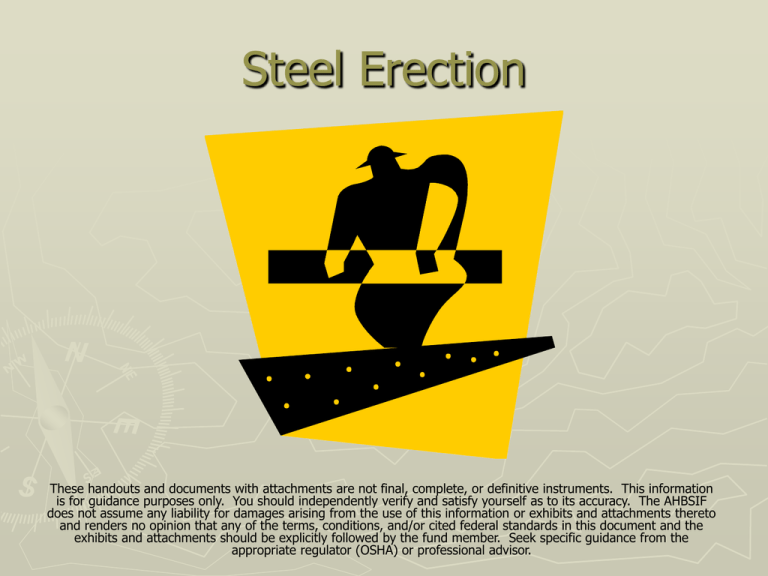
Steel Erection These handouts and documents with attachments are not final, complete, or definitive instruments. This information is for guidance purposes only. You should independently verify and satisfy yourself as to its accuracy. The AHBSIF does not assume any liability for damages arising from the use of this information or exhibits and attachments thereto and renders no opinion that any of the terms, conditions, and/or cited federal standards in this document and the exhibits and attachments should be explicitly followed by the fund member. Seek specific guidance from the appropriate regulator (OSHA) or professional advisor. Scope The standard covers all employees engaged in steel erection Two lists of activities covered Primary Ancillary Activities not covered Electrical Transmission Towers Communication and Broadcast Towers Tanks Controlling Contractor Responsibilities ► Erector must be provided with an approval to begin steel erection ► Location must have adequate on-site access roads (firm, properly graded) ► Trades working under steel erection must have overhead protection ► If fall protection is left behind by the erector, it must be maintained or removed Erection Plan ► Plan must be site specific and include the following: Approval to begin steel erection Written notifications furnished to erectors Footings and Walls must be adequate to support structure Site Layout Provisions Pre-planning of overhead hoisting operations Hoisting and Rigging ► Mobile ► Crane Inspection The following items must be inspected at minimum; Wire rope and reeving Electrical equipment All operational aids Control mechanisms Fluid Levels Tires Hooks and latches Hydraulic system Hoisting and Rigging ►A Qualified Rigger must Inspect all rigging prior to the start of work Rig all loads ► Equipment may not be ridden at any time ► Equipment must be removed from service if faulty in any way ► Only connectors and riggers are allowed under loads Hoisting and Rigging ► Christmas Treeing Maximum of 5 pieces Lifted material must be of similar type Decking bundles are prohibited Employees must be trained in procedure Multiple lift assembly must be professionally engineered Crane manufacturer must allow procedure Hoisting and Rigging ► Christmas Treeing, Items for Consideration: Weight of each piece Sling size Hook size and type Shackle Size ►Hoisting using bundle straps or bands is prohibited Structural Assembly ►8 floors maximum between erection floor and uppermost permanent floor ► Maximum 4 floors unfinished bolting ► Fully decked or protected by nets within two floors or 30 ft under erection work ► Metal deck openings turned down ► Holes cut immediately prior to filling Structural Assembly ► Walking surface must be installed before shear connectors ► Decking must be laid tight and secured immediately ► Placement must be for full structural support ► Derrick floors must be fully planked and bolted Structural Assembly ► Covers For vehicular traffic – 2 times the maximum axle load of the largest vehicle Foot traffic – 2 times the weight of the expected load Secured to prevent displacement Marked “HOLE” or “COVER” or color coded Decking holes around columns must be protected Domes or fixtures are not rated covers unless built for such use Structural Assembly ► ► ► ► Structure must be plumbed to insure stability Plum cables must be installed before constructions are placed on structure Loose items must be secured at all times Decking joists must landed in accordance with 757(e)(4) Column Anchorage ►4 anchor bolts per column ► Column must withstand 300 lb eccentric gravity load from 18” at column top ► Must be set on floors, plates, or packs adequate to transfer construction loads ► Competent Person evaluates bracing requirements ► Structural Engineer must approve any repairs or modifications to the anchor rods ► Controlling Contractor must provide written notification for any repair or modification to the column Beams & Columns ►2 bolts per connection prior to releasing the hoist line ► Solid web members for diagonal bracing one bolt wrench tight minimum ► One bolt must remain connected for double connections unless seat or equivalent is used ► Seats for double connections shall be designed for the load during the double connection process Beams & Columns ► Double Connection Requirements: The connector has to back out the bolts Beam must be held in place with a spud wrench When second beam, arrives, align and hold with spud wrench Push bolts back through first beam into second beam and secure ► Double Connections at columns and beam webs over a column At least one bolt or similar connection device must be present (i.e. beam seat) ► Perimeter columns must extend 48” for safety cable installation and must have holes for cables at either 42” or 45” Joists ► Joists field bolted at columns unless columns are framed in at least two directions ► Vertical stabilizer plates provided on each column for joists ► Hoisting cables shall not be released until joist is bolted ► Vertical stabilizer plates are required for each column of steel joists Joists ► Joist placement not at a column ► Alternate means used to stabilize joists on both sides of the column ► Erection procedure designed by Qualified Person ► Procedure incorporates joist stability, shop installed connections, and erection drawings ► Hoisting cables shall not be released until both ends are bolted and joist is stabilized Engineered Metal Buildings ► Rigid frames shall have 50% of their bolts or the number specified by the manufacturer installed and tightened on both sides of the web adjacent to each flange before hoisting equipment is released ► Construction loads shall not be placed on any structural steel framework unless such framework is safely bolted, welded, or otherwise secured Fall Protection ► Fall protection is required at heights greater than 2 stories or 30’ (Includes connectors and deckers) ► Protection is required between 15’ and 30’ Fall Protection ► Controlled Zone Decking Allows connectors to work without conventional fall protection May be established in an area within the structure over 15’ and up to 30’ above a lower level CDZ shall not be more than 90’ wide and 90’ deep from any leading edge CDZ perimeter must be designated by warning lines Only trained employees can enter the CDZ
